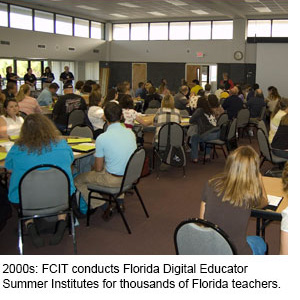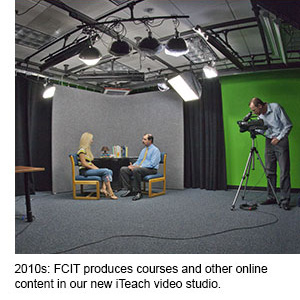Background and Development of the TIM
The Technology Integration Matrix (TIM) was developed to help guide the complex task of evaluating technology integration in the classroom. It provides a common vocabulary for pedagogically sound technology integration for teachers, school leaders, coaches, researchers, evaluators, and professional development facilitators. The theoretical framework of the TIM is based in constructivist learning theory and research related to teacher practice. In contrast to other models for technology integration, the TIM is designed to evaluate a lesson, as opposed to rating a teacher or judging a discrete task.
The original TIM was developed in 2003-2006 with funding from the Enhancing Education Through Technology (EETT) program under Title II, Part D No Child Left Behind Act of 2001. The second edition of the TIM (2010-2011) was created with funding from the Elementary and Secondary Education Act, Title II-D of NCLB and the American Recovery and Reinvestment Act (ARRA). The matrix descriptors were revised and expanded, and video examples were added for Math, Science, Language Arts, and Social Studies. The third edition of the TIM (2019) includes minor tweaks clarifying some of the summary and extended descriptors. Archived PDFs of the first and second editions are maintained for researchers interested in the development of the TIM.
As part of the development of the original and subsequent editions of the TIM, educator focus groups, field tests, public surveys, and usability studies were conducted. Links to additional information regarding the theoretical foundations of the TIM may be found in the Research section.
For more information about the about the early days of the TIM, please see the post, A Teenager in the House: TIM Turns 13! from our Teaching and Learning with Technology blog.
About the Florida Center for Instructional Technology
 Established in 1982, the Florida Center for Instructional Technology (FCIT) at the University of South Florida (USF) has been a leader in working with educators to integrate technology into the curriculum for over 30 years.
Established in 1982, the Florida Center for Instructional Technology (FCIT) at the University of South Florida (USF) has been a leader in working with educators to integrate technology into the curriculum for over 30 years.
In the early days, FCIT provided online tutorials as well as face-to-face training at our Tampa location. At that time, our professional development focused on finding appropriate programs for use in school computer labs and how to use the newly-established Florida Information Resource Network (FIRN). When not reserved for training sessions, our lab functioned as an active preview center for teachers in the Tampa Bay region. In those days before widespread connectivity, FCIT relied on print publications and diskettes for much of our professional development outreach. Major grants from IBM in the 1980s helped familiarize schools with microcomputers and served as a catalyst for the creation of the Instructional Technology graduate programs at USF. In the 1990s, support from Apple and from Microsoft allowed us to offer additional professional development opportunities for teachers.
 By the turn of the century, FCIT was conducting over 100 full-day workshops every year on a variety of technology topics at our Tampa location and at other locations around the state on demand. A team of Educational Technology Integrators (ETIs) was funded by the Florida Department of Education to provide ongoing training and support for all districts across the state. The Center also began our online collections of digital content (maps, photos, clipart, audiobooks, etc.) to support classroom technology integration activities. Currently, we serve up between two and three million digital assets from these collections each school day.
By the turn of the century, FCIT was conducting over 100 full-day workshops every year on a variety of technology topics at our Tampa location and at other locations around the state on demand. A team of Educational Technology Integrators (ETIs) was funded by the Florida Department of Education to provide ongoing training and support for all districts across the state. The Center also began our online collections of digital content (maps, photos, clipart, audiobooks, etc.) to support classroom technology integration activities. Currently, we serve up between two and three million digital assets from these collections each school day.
In the 2000’s, we expanded our training offerings to include Florida Digital Educator four-day institutes that were conducted in all regions of Florida each year. Along with the Master Digital Educator program, which was also available for graduate credit at USF, these statewide trainings contributed to the development of many of today’s technology leaders in Florida. By 2005, our experiences working with teachers to more effectively integrate technology into their classrooms led to the development of the Technology Integration Matrix, a practical guide for teachers striving to take their teaching practices to the next level.
 Responding to new demands and frequent requests from beyond Florida, FCIT now offers fully online courses through the iTeach Professional Learning program. These month-long courses are available to educators and administrators around the world. Our experienced facilitators, lead participants through activities designed to be of immediate practical application in their roles as educators or administrators. The Technology Integration Matrix courses are of particular interest to districts, states, and even entire ministries of education that have adopted the TIM as their model for technology integration. We are also seeing a wider international use of the TIM Tools to support technology integration in schools.
Responding to new demands and frequent requests from beyond Florida, FCIT now offers fully online courses through the iTeach Professional Learning program. These month-long courses are available to educators and administrators around the world. Our experienced facilitators, lead participants through activities designed to be of immediate practical application in their roles as educators or administrators. The Technology Integration Matrix courses are of particular interest to districts, states, and even entire ministries of education that have adopted the TIM as their model for technology integration. We are also seeing a wider international use of the TIM Tools to support technology integration in schools.
Credits
2005-2009 Development Team
- Kate Kemker, Florida Department of Education
- Roy Winkelman, Ph.D., FCIT Director
- Margaret Murphy Allsopp, Project Manager
- Roberto Herrera, Principal Videographer and Video Editor
- Tina Hohlfeld, Ph.D., Indicator Development
- Erica McCray, Ph.D., Lesson Plan Editor and School Liaison
- Angel Quiles, Videographer & Video Editor
- Vanessa Minick
- Luis Perez
- Jason Perry
- Cory Plastek
- Kim Schwartz
- James Welsh
- Rachel Wokenhauer
Special Thanks To:
- Pinellas County K-12 Instructional Technology Coordinators
- Florida Council of Instructional Technology Leaders (FCITL)
- Leslie Leduc, Manatee County
- Don Manderson, Escambia County
- Patricia Horn, Ph.D., St. Johns County
- Po Dickison, Seminole County
- James P. Love, Gadsen County
- Cathy Cavanaugh, Ph.D., University of Florida
- Pauline Luther
- Ann Smith, Pinellas County School District
- Jennifer Showermen, Pinellas County School District
- Michelle Frankich, Pinellas County School District
- Kristine Haller, Broward County School District
The first edition (2005) of the Technology Integration Matrix was developed with funding from the Enhancing Education Through Technology (EETT) program under Title II-D of NCLB.
2010-2011 Development Team
- Kate Kemker, Ph.D., Florida Department of Education
- Roy Winkelman, Ph.D., FCIT Director
- James Welsh, Project Manager
- Allison Papke, Coordinator, Lesson Plan Editor, and School Liason
- Roberto Herrera, Videographer and Video Editor
- Kyle Wahling, Videographer
- Francisco Flores, Video Editor
- James Basom Seaman, Web Design and Development
- J. Christine Harmes, Ph.D., Indicator Development
- R. Ryan Dial, Programming and Development
Special Thanks To:
- Michael Sweeney, Florida Digital Educator Program
- C. Kris Mathews, Florida Digital Educator Program
- G. Gordon Worley, Florida Digital Educator Program
- Jeanine Gendron, Ph.D., Broward County Schools
- John Lien, Orange County Schools
- Dawn Howard, Manatee County Schools
- Don Manderson, Escambia County
- Kara Dawson, Ph.D., University of Florida
- Mijana Lockard, Lincoln Avenue Academy, Lakeland, FL
- Virginia Richard, School Technology Services, Polk County
- Trevor Honohan, Principal, Audubon Park Elementary
- Kristine Haller
- Nancy Kuznicki
- Jeanne Rogers
- Crystal Gasell
- David Schneider
- David Futch
- Alvin Olivo
- Sylvia Hernandez
- Maria Alves
- Lois Hooper
- Cheryl Woolwine
- Jennifer O’Dell
- Ana McMoran
The second edition (2011) of the Technology Integration Matrix expanded matrix descriptors and added video examples for Math, Science, Language Arts, and Social Studies. It was developed with funding from the Elementary and Secondary Education Act, Title II, Part D No Child Left Behind Act of 2001 and the American Recovery and Reinvestment Act.
2012-2019 Development Team
- James Welsh, Ph.D., FCIT Director
- J. Christine Harmes, Ph.D., Researcher
- Derek Christian, Video Editor
- Roy Winkelman, Ph.D., Web Resources
- Gordon Worley, Videographer
- James Basom Seaman, Web Design and Development
- R. Ryan Dial, Programming and Development
- Chet Lyskawa, Ph.D., Programming and Development
Special Thanks To:
- Marta Alvarez
- Mauricio Burgos
- Julie Ann Cannon
- Susan Collado
- Andrea Distelhurst
- Jason Dudczak
- Andy Dunn
- Tracey Gillies
- Jennifer Hart
- Dawn Howard
- Jennifer Jaworski
- Pat Kennedy
- John Lien
- Alexis Mabe
- Kristin Mahoney
- Cherish L. Manson
- Melba Munguia
- Willian Neris
- Fredy Padovan
- Allison Papke
- Christy Rankin
- Meredith Roe
- Karen Russell
- Maggie Santana
- Victoria Seawall
- Rebecca Shaw
- Michele Skelly
- Gerard Sukhram
- Monica Taylor
- Joan Thomas
- Juan Vila
- Shaun Walker
- Stan Wexler
- Robyn White
- Monica Wildenburg
- Nathan Wolkenhauer
- Lee-Anne Keith Yerkey
- Vanessa York
The third edition (2019) of the Technology Integration Matrix includes minor text revisions to clarify some of the summary and extended descriptors. The TIM website was greatly expanded in 2017 to include hundreds of supporting resources for school and district use.
The TIM Evaluation Tools were initially developed with University of South Florida research initiative funds. Ongoing development of the Evaluation Tools is funded by TIM Tools licensing fees.
